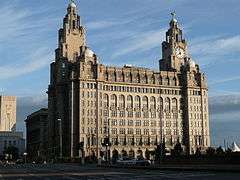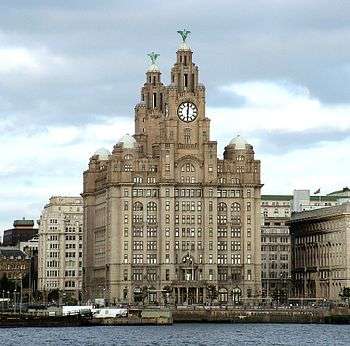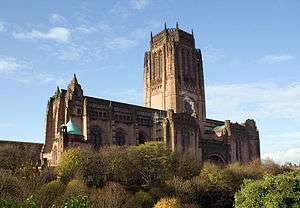Royal Liver Building
| Royal Liver Building | |
|---|---|
 Royal Liver Building, Pier Head, Liverpool | |
| Alternative names |
|
| General information | |
| Type | Commercial offices |
| Location | Pier Head, Liverpool, England, United Kingdom |
| Coordinates | 53°24′21″N 2°59′45″W / 53.4058°N 2.9958°WCoordinates: 53°24′21″N 2°59′45″W / 53.4058°N 2.9958°W |
| Current tenants | Royal Liver Assurance |
| Construction started | 1908 |
| Completed | 1911 |
| Cost | £800,000 |
| Owner | Royal London Mutual Insurance Society Limited |
| Height | |
| Architectural | 98.2 m (322 ft) |
| Roof | 50.9 m (167 ft) |
| Technical details | |
| Lifts/elevators | 12 |
| Design and construction | |
| Architect | Walter Aubrey Thomas |
| Main contractor | Edmund Nuttall Limited |
| References | |
| [1][2][3][4] | |
The Royal Liver Building /ˈlaɪvər/ is a Grade I listed building in Liverpool, England. It is located at the Pier Head and along with the neighbouring Cunard Building and Port of Liverpool Building is one of Liverpool's Three Graces, which line the city's waterfront. It is also part of Liverpool's UNESCO-designated World Heritage Maritime Mercantile City.
Opened in 1911, the building is the purpose-built home of the Royal Liver Assurance group, which had been set up in the city in 1850 to provide locals with assistance related to losing a wage-earning relative. One of the first buildings in the world to be built using reinforced concrete, the Royal Liver Building stands at 98.2 m (322 ft) tall to the top of the spires, and 50.9 m (167 ft) to the main roof. It was the tallest storied building in Europe from completion until 1932[5] and the tallest in the United Kingdom until 1961. The Royal Liver Building is now however only the joint-fourth tallest structure in the City of Liverpool, having been overtaken in height by West Tower, Radio City Tower and Liverpool Cathedral.
Today the Royal Liver Building is one of the most recognisable landmarks in the city of Liverpool and is home to two fabled Liver Birds that watch over the city and the sea. Legend has it that were these two birds to fly away, then the city would cease to exist.
History
In 1907 the Royal Liver Group had over 6,000 employees and given the need for larger premises the company gave the go-ahead for the construction of a new head office. Designed by Walter Aubrey Thomas, the foundation stone for the building was laid on 11 May 1908 and just 3 years later, on 19 July 1911, the building was officially opened by Lord Sheffield.[6] The building became the first major structure in Britain, and one of the first buildings in the world, to be constructed using reinforced concrete,[7] and given the building's radical design was considered by some to be impossible to build.[6]
Since its completion in 1911, it has overlooked the River Mersey from its waterfront location on the Pier Head and forms one of the 'Three Graces' along with the Port of Liverpool Building and the Cunard Building. This is reflected in the building's Grade I listed building status. It stands at 98.2 m (322 ft) tall and has 13 floors.
The building is crowned by a pair of clock towers: as a ship passed along the river, mariners could tell the time from these. The clocks were made by Gent and Co. of Leicester.[8] The clock faces are 7.6 m (25 ft) in diameter, larger than those of London's famous landmark, the Great Westminster Clock, holding the distinction of being the largest electronically driven clocks in the UK.[9] They were originally named George clocks, because they were started at the precise time that King George V was crowned on 22 June 1911.[10] In 1953 electronic chimes were installed to serve as a memorial to the members of the Royal Liver Friendly Society who died during the two World Wars. During hours of darkness, the clock dials are illuminated.
Atop each tower stand the mythical Liver Birds, designed by Carl Bernard Bartels. The birds are named Bella and Bertie, looking to the sea and inland, respectively.[11][nb 1] Popular legend has it that while one giant bird looks out over the city to protect its people, the other bird looks out to sea at the new sailors coming in to port. Alternatively, local legend states one Liver Bird is male, looking inland to see if the pubs are open, whilst the other is female, looking out to sea to see if there are any handsome sailors coming up the river. Yet another local legend, reflecting Liverpudlians' cynicism, avers that every time a virgin walks across the Pier Head, the Liver Birds flap their wings. It is also said that, if one of the birds were to fly away the city of Liverpool would cease to exist, thus adding to the mystery of the birds. As a result, both birds are chained to the domes upon which they stand; although this could simply be because the originally gilded Liver birds, of a moulded and hammered copper construction (that is itself fixed onto a rolled-steel armature) are eighteen feet high, ten feet long and themselves carry in their beaks an intricately cast sprig of seaweed. Additionally, however, their heads are three-and-a-half feet long, their wing spread is twelve feet and their legs measure two feet in circumference. The two birds - officially cormorants - have identical and almost traditional poses, standing upright with half-raised wings.
During the early 1950s the sixth floor was occupied and used by No 3 Movements Unit (Embarkation) of the Royal Air Force, overseeing and controlling the movement of RAF personnel and goods through the port.
The building remains the head office for the Royal Liver Assurance. More akin to the early tall American skyscrapers, the Royal Liver Building closely resembles H. H. Richardson's Allegheny Court House (built in 1884) and Adler & Sullivan's Schiller Theatre - with no definitive exterior styling but eclectic references to the Baroque and Byzantine.
In October 2016, the building was put up for sale for the first time in its history.[12] The owner instructed CBRE Group to list the sale with a guide price of more than £40m.[13]
Tenants
There are currently 15 tenants in the Royal Liver Building. They are:
- Amaze
- Captivate Presentations[14]
- Crowd Mortgage
- Tilney Bestinvest
- Easirent
- Epic New Media
- Grant Thornton
HSBC
- ITV[15]
- Mott MacDonald
- The Venue at the Royal Liver Building
- Pershing
- Princes Group[16]
- Publiship[17]
- Richard Hogg Lindley
- USS
Gallery
 The Royal Liver Building
The Royal Liver Building The Royal Liver Building - Liverpool Mathew Street Music Festival 2006
The Royal Liver Building - Liverpool Mathew Street Music Festival 2006 Liver birds tower over Dale Street and the Town Hall
Liver birds tower over Dale Street and the Town Hall- The Royal Liver Building, seen from the nearby Atlantic Tower
 One of the towers
One of the towers One of the two Liver Birds that sit atop each tower of the building
One of the two Liver Birds that sit atop each tower of the building The Royal Liver Building is floodlit at night
The Royal Liver Building is floodlit at night
See also
Notes
- ↑ Bella may possibly be named for Isabella of Angoulême, the queen consort of King John, when Liverpool was granted its royal charter. Bertie may possibly be named for Edward VII, who was known as Bertie to the royal family and who was one of the reigning monarchs, at the time of the building's construction.
References
- ↑ "Royal Liver Building". CTBUH Skyscraper Database.
- ↑ Royal Liver Building at Emporis
- ↑ "Royal Liver Building". SkyscraperPage.
- ↑ Royal Liver Building at Structurae
- ↑ At which point it was passed by the Boerentoren in Antwerp, Belgium
- 1 2 "Rapid Growth 1886-1913". Royal Liver Group. Retrieved 29 September 2008.
- ↑ Hughes, Quentin (1999). Liverpool: City of Architecture. The Bluecoat Press. Check date values in:
|access-date=(help); - ↑ "The story of the Royal Liver Building and the people who shaped the organisation behind it." (PDF). Friends of Royal Lyver. p. 9. Retrieved 22 November 2015.
- ↑ "Port Cities: The Royal Liver Building". E. Chambré Hardman Archive. Retrieved 1 February 2008.
- ↑ "Coast Walk: Stage 4". BBC Liverpool. 21 July 2005. Retrieved 1 February 2008.
- ↑ Coen, Susie (25 September 2016). "Seven things you didn't know about our Liver Birds". Liverpool Echo. Retrieved 18 October 2016.
- ↑ "Liverpool's Royal Liver building is put up for sale". BBC News. 17 October 2016. Retrieved 18 October 2016.
- ↑ Dunn, Connor (17 October 2016). "The Royal Liver Building to be put on sale for the first time in its history". Liverpool Echo. Retrieved 18 October 2016.
- ↑ "Captivate Presentations". http://captivatepres.com. External link in
|website=(help) - ↑ "ITV". http://itv.com. External link in
|website=(help) - ↑ McDonough, Tony (13 January 2015). "Liverpool food group Princes sees profits up by £8m as it takes total control of Napolina". Liverpool Echo. Retrieved 18 October 2016.
- ↑ "Home". Publiship. Retrieved 18 October 2016.
External links
| Wikimedia Commons has media related to Royal Liver Building. |
| Records | ||
|---|---|---|
| Preceded by Midland Grand Hotel |
Tallest Building in the United Kingdom 1911—1961 90m |
Succeeded by Shell Centre |
| Preceded by Port of Liverpool Building |
Tallest Building in Liverpool 1911—1965 90m |
Succeeded by Radio City Tower |


